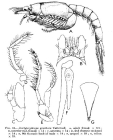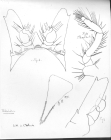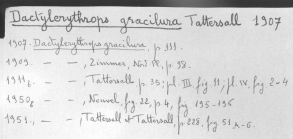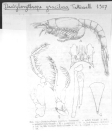Mysidacea name details
Dactylerythrops gracilura W. Tattersall, 1907
119991 (urn:lsid:marinespecies.org:taxname:119991)
unaccepted > superseded combination (basionym; gender disagreement)
Species
marine, fresh, terrestrial
Tattersall, W.M. 1907. Preliminary diagnoses of six new Mysidae from the west coast of Ireland.-- The Annals and Magazine of Natural History, Series 7, 19: 106-118. [details] 
Depth range 1500m
Taxonomic remark Email from Karl Wittmann to Jan Mees dd 8-9-2015: Many species names of Erythropinae are badly spelled. In those cases...
Depth range 1500m [details]
Taxonomic remark Email from Karl Wittmann to Jan Mees dd 8-9-2015: Many species names of Erythropinae are badly spelled. In those cases...
Taxonomic remark Email from Karl Wittmann to Jan Mees dd 8-9-2015: Many species names of Erythropinae are badly spelled. In those cases where the genus name ends with "-ops" and the species name is an adjective, the name has to be transferred from female to male gender. [details]
Mees, J.; Meland, K. (Eds) (2012 onwards). World List of Lophogastrida, Stygiomysida and Mysida. Dactylerythrops gracilura W. Tattersall, 1907. Accessed at: https://www.marinespecies.org/mysidacea/aphia.php?p=taxdetails&id=119991 on 2025-03-28
Date
action
by
original description
Tattersall, W.M. 1907. Preliminary diagnoses of six new Mysidae from the west coast of Ireland.-- The Annals and Magazine of Natural History, Series 7, 19: 106-118. [details] 
context source (Deepsea) Intergovernmental Oceanographic Commission (IOC) of UNESCO. The Ocean Biogeographic Information System (OBIS), available online at http://www.iobis.org/ [details]
basis of record van der Land, J.; Brattegard, T. (2001). Mysidacea. <em>In: Costello, M.J. et al. (Ed.) (2001). European register of marine species: a check-list of the marine species in Europe and a bibliography of guides to their identification. Collection Patrimoines Naturels.</em> 50: pp. 293-295. (look up in IMIS) [details]
additional source Price, W. (2001). World list of Mysidacea. [details]
additional source Müller, H. G. (1993). World catalogue and bibliography of the recent Mysidacea. 238p. [details] Available for editors
additional source Tattersall, W.M.; Tattersall, O.S. (1951). The British Mysidacea. <em>Ray Society, London.</em> 1-460, figs. 1-118. (look up in IMIS) [details] Available for editors
additional source Wooldridge, T. H.; Mees, J. (2011 onwards). World List of the Mysidacea. [details]
additional source MAUCHLINE, J. (1986). The biology of the deep-sea species of Mysidacea (Crustacea) of the Rockall Trough. - J. Mar. Biol. Ass. U.K., 66 (4): 803-825. [Boreomysis inermis [details] Available for editors
redescription Gordan, J. (1957). A bibliography of the order Mysidacea. <em>Bull. Am. Mus. Nat. Hist.</em> 112 (4): 281-393. [details] Available for editors
redescription Mauchline, J.; Murano, M. (1977). World list of the Mysidacea, Crustacea. <em>J. Tokyo Univ. Fish.</em> 64 (1): 39-88. (look up in IMIS) [details]
redescription Tattersall, W. M. (1911). Schizopodous Crustacea from the northeast Atlantic slope. <em>Second supplement. Fisheries, Ireland, Sci. Invest. 1910.</em> II: 1-77, plates I-VIII. (look up in IMIS) [details]
identification resource Tattersall, W.M.; Tattersall, O.S. (1951). The British Mysidacea. <em>Ray Society, London.</em> 1-460, figs. 1-118. (look up in IMIS) [details] Available for editors
identification resource Zimmer C. (1909): Die nordischen Schizopoden. K. Brandt & C. Apstein (eds.), Nordisches Plankton. Lipsius und Tischler, Kiel und Leipzig, 6: 1-178 [details]
context source (Deepsea) Intergovernmental Oceanographic Commission (IOC) of UNESCO. The Ocean Biogeographic Information System (OBIS), available online at http://www.iobis.org/ [details]
basis of record van der Land, J.; Brattegard, T. (2001). Mysidacea. <em>In: Costello, M.J. et al. (Ed.) (2001). European register of marine species: a check-list of the marine species in Europe and a bibliography of guides to their identification. Collection Patrimoines Naturels.</em> 50: pp. 293-295. (look up in IMIS) [details]
additional source Price, W. (2001). World list of Mysidacea. [details]
additional source Müller, H. G. (1993). World catalogue and bibliography of the recent Mysidacea. 238p. [details] Available for editors
additional source Tattersall, W.M.; Tattersall, O.S. (1951). The British Mysidacea. <em>Ray Society, London.</em> 1-460, figs. 1-118. (look up in IMIS) [details] Available for editors
additional source Wooldridge, T. H.; Mees, J. (2011 onwards). World List of the Mysidacea. [details]
additional source MAUCHLINE, J. (1986). The biology of the deep-sea species of Mysidacea (Crustacea) of the Rockall Trough. - J. Mar. Biol. Ass. U.K., 66 (4): 803-825. [Boreomysis inermis [details] Available for editors
redescription Gordan, J. (1957). A bibliography of the order Mysidacea. <em>Bull. Am. Mus. Nat. Hist.</em> 112 (4): 281-393. [details] Available for editors
redescription Mauchline, J.; Murano, M. (1977). World list of the Mysidacea, Crustacea. <em>J. Tokyo Univ. Fish.</em> 64 (1): 39-88. (look up in IMIS) [details]
redescription Tattersall, W. M. (1911). Schizopodous Crustacea from the northeast Atlantic slope. <em>Second supplement. Fisheries, Ireland, Sci. Invest. 1910.</em> II: 1-77, plates I-VIII. (look up in IMIS) [details]
identification resource Tattersall, W.M.; Tattersall, O.S. (1951). The British Mysidacea. <em>Ray Society, London.</em> 1-460, figs. 1-118. (look up in IMIS) [details] Available for editors
identification resource Zimmer C. (1909): Die nordischen Schizopoden. K. Brandt & C. Apstein (eds.), Nordisches Plankton. Lipsius und Tischler, Kiel und Leipzig, 6: 1-178 [details]
 Present
Present  Inaccurate
Inaccurate  Introduced: alien
Introduced: alien  Containing type locality
Containing type locality
From editor or global species database
Depth range 1500m [details]Taxonomic remark Email from Karl Wittmann to Jan Mees dd 8-9-2015: Many species names of Erythropinae are badly spelled. In those cases where the genus name ends with "-ops" and the species name is an adjective, the name has to be transferred from female to male gender. [details]




